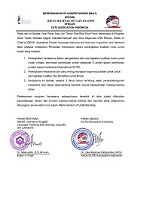Students’ Perception of Blended Learning at Junior High School (Combination of Synchronous and Asynchronous Learning)
DOI:
https://doi.org/10.24256/ideas.v10i2.3034Keywords:
Asynchronous Learning, Blended Online Learning, Synchronous Learning.Abstract
Since the pandemic era, the process of teaching and learning has changed. Teachers and educators need to choose the appropriate learning model. This study aims to find out the suitable model learning between two models there are synchronous and asynchronous learning models. The study involved two classes, A-class (32 students) and B-class (35 students) of seven grade students at SMP Negeri 2 Tejakula. Data was collected by online questionnaire and shared via WhatsApp. The data were analyzed with the descriptive qualitative method by counting the mean of the Likert scale. The result shows that the student prefers to choose the asynchronous learning model, with the percentage of asynchronous learning at 69% and the synchronous learning model at 63%. It indicates two learning models can be implemented, but the suggestion to the teacher uses the asynchronous model to gain students’ participation.
References
Aliyyah, R. R., Reza, R., Achmad, S., Syaodih, E., Nurtanto, M., Sultan, A., Riana, A., & Tambunan, S. (2020). The Perceptions of Primary School Teachers of Online Learning during the COVID-19 Pandemic Period : A Case Study in Indonesia. Journal of Ethnic and Cultural Studies, 7(2), 90–109.
Cahyani, N. M. W. S., Suwastini, N. K. A., Dantes, G. R., Jayantini, I. G. A. S. R., & Susanthi, A. A. D. (2021). Blended Online Learning : Combining the Strengths of Synchronous and Asynchronous Online Learning in Efl Context. Jurnal Pendidikan Teknologi Dan Kejuruan, 18(2), 174–184. https://ejournal.undiksha.ac.id/index.php/JPTK/article/view/34659/19434
Cheung, A. (2021). Synchronous online teaching, a blessing or a curse? Insights from EFL primary students’ interaction during online English lessons. System, 100(June), 102566. https://doi.org/10.1016/j.system.2021.102566
Chiu, T. K. F. (2021). Digital support for student engagement in blended learning based on self-determination theory. Computers in Human Behavior, 124(March), 106909. https://doi.org/10.1016/j.chb.2021.106909
Gheytasi, M., Azizifar, A., & Gowhary, H. (2015). The Effect of Smartphone on the Reading Comprehension Proficiency of Iranian EFL Learners. Procedia - Social and Behavioral Sciences, 199, 225–230. https://doi.org/10.1016/j.sbspro.2015.07.510
Immanuel, G., Sankar, G., Saravanan, V., & Jose, M. (2021). Significance of interpersonal skills and english language teaching. Materials Today: Proceedings, xxxx. https://doi.org/10.1016/j.matpr.2020.11.933
Intan Nuyulis Naeni Puspitasari. (2021). Combination of Synchronous and Asynchronous Models in Online Learning. Jurnal Pendidikan Islam Indonesia. https://doi.org/10.35316/jpii.v5i2.301
Lalian, O. N., Siregar, E., & Winarsih, M. (2021). Blended Learning for Vocational High School Students. Kwangsan: Jurnal Teknologi Pendidikan, 9(1), 18. https://doi.org/10.31800/jtp.kw.v9n1.p18--30
Lalima, D., & Lata Dangwal, K. (2017). Blended Learning: An Innovative Approach. Universal Journal of Educational Research, 5(1), 129–136. https://doi.org/10.13189/ujer.2017.050116
Li, J., Brar, A., & Roihan, N. (2021). The use of digital technology to enhance language and literacy skills for Indigenous people: A systematic literature review. Computers and Education Open, 2(March), 100035. https://doi.org/10.1016/j.caeo.2021.100035
Oztok, M., Zingaro, D., Brett, C., & Hewitt, J. (2013). Exploring asynchronous and synchronous tool use in online courses. Computers and Education, 60(1), 87–94. https://doi.org/10.1016/j.compedu.2012.08.007
Pinto-Llorente, A. M., Sánchez-Gómez, M. C., GarcÃa-Peñalvo, F. J., & Casillas-MartÃn, S. (2017). Students’ perceptions and attitudes towards asynchronous technological tools in blended-learning training to improve grammatical competence in English as a second language. Computers in Human Behavior, 72, 632–643. https://doi.org/10.1016/j.chb.2016.05.071
Sanoto, H. (2021). Online Learning Management in The Covid-19 Pandemic Era. JETL (Journal of Education, Teaching and Learning). https://doi.org/10.26737/jetl.v6i1.2358
Sari, S. P., Asty, H., & Yelliza, Y. (2021). The Implementation of Blended Learning in Teaching English During Covid-19 at Senior High School. Jurnal Pendidikan Tambusai, 2(2), 70–78. https://jptam.org/index.php/jptam/article/view/1878
Wang, N., Chen, J., Tai, M., & Zhang, J. (2019). Blended learning for Chinese university EFL learners: learning environment and learner perceptions. Computer Assisted Language Learning, 34(3), 297–323.
Yang, J., Yu, H., & Chen, N. shing. (2019). Using blended synchronous classroom approach to promote learning performance in rural area. Computers and Education, 141(June), 103619. https://doi.org/10.1016/j.compedu.2019.103619
Yeh, H. C., & Lai, W. Y. (2019). Speaking progress and meaning negotiation processes in synchronous online tutoring. System, 81, 179–191. https://doi.org/10.1016/j.system.2019.01.001
Yekefallah, L., Namdar, P., Panahi, R., & Dehghankar, L. (2021). Factors related to students’ satisfaction with holding e-learning during the Covid-19 pandemic based on the dimensions of e-learning. Heliyon, 7(7), e07628. https://doi.org/10.1016/j.heliyon.2021.e07628
Downloads
Published
Issue
Section
Citation Check
License
Authors retain copyright and grant the journal right of first publication with the work simultaneously licensed under an Attribution-ShareAlike 4.0 International (CC BY-SA 4.0) that allows others to share the work with an acknowledgement of the work's authorship and initial publication in this journal.
Authors are able to enter into separate, additional contractual arrangements for the non-exclusive distribution of the journal's published version of the work (e.g., post it to an institutional repository or publish it in a book), with an acknowledgement of its initial publication in this journal.
Authors are permitted and encouraged to post their work online (e.g., in institutional repositories or on their website) prior to and during the submission process, as it can lead to productive exchanges, as well as earlier and greater citation of published work (See the Effect of Open Access)



